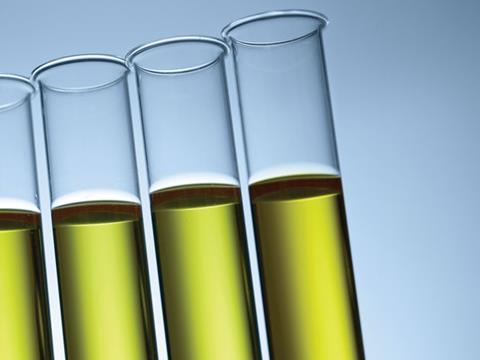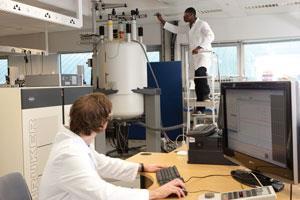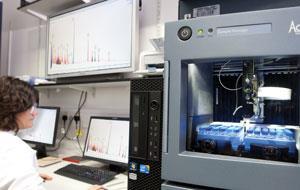Andy Extance finds out how British researchers are turning Olympic anti-doping facilities into a world-leading facility to understand the links between metabolism, chemicals and health
Andy Extance finds out how British researchers are turning Olympic anti-doping facilities into a world-leading facility to understand the links between metabolism, chemicals and health

Analytical chemistry, including NMR spectroscopy and chromatography-coupled mass spectrometry, will power the centre, based at Imperial College London’s Hammersmith Hospital. Combined with multivariate statistical analysis and pattern recognition – including approaches pioneered by centre director Jeremy Nicholson’s team – they already provide medically beneficial insights. But now the scientists must deliver the Phenome Centre’s target of examining 100,000 samples a year, helping identify further disease biomarkers to enable novel diagnostic tools and personalised medicine.

With much of the equipment cost already laid out, the scientists reckoned another £10 million would deliver a centre that could ultimately sustain itself. To Nicholson’s satisfaction, the National Institute for Healthcare Research (NIHR) of the UK’s National Health Service and the country’s Medical Research Council (MRC) found the bid ‘spectacular’ enough to back. Arguably part of the metabolomics field, which measures and maps tissue and cellular biochemicals typically below 1000 Da, the MRC-NIHR Phenome Centre’s name reflects its broader focus (see 'Know your ome' box below). ‘The individual cellular metabolome is the snapshot result of the integrated activity of physiology and biochemistry,’ Nicholson explains. ‘The phenome more broadly reflects the result of how genes, environment and lifestyle meet and interact, and the expression of those interactions in biochemical and physical terms. What’s also different is that we include exogenous chemicals, like drugs and pollutants – the so-called exposome.’
Know your ome
Metabolome: The complete set of small molecule metabolites in a biological sample, which continuously varies.
Metabolomics: Analysis of biological sample composition to identify metabolites and establish their concentration.
Phenotype: An organism’s observable traits or characteristics, resulting from interaction between genes and environment.
Phenome: The sum of all phenotypic traits. The ‘phenome’ that the Phenome Centre will be analysing will be the metabolome plus compounds in the body originating from external sources.
Phenomics: The study of how phenomes change in response to genetic mutation and environmental influences. Usually refers to collecting data on an individual organism’s phenotype using multiple techniques.
Fresh from pharma
Metabolomics builds on methods pinpointing the metabolites that distinguish between biological responses that Nicholson developed with his Imperial colleague John Lindon over 20 years ago. Lindon’s group at Wellcome Research Laboratories, one of the companies that merged to form GSK, provided know-how and computational power for those early experiments. ‘We published the first papers using NMR and pattern recognition to classify urine samples from rats according to model drug toxicity,’ Lindon recalls.
Today, these methods help find risk factors for diseases like diabetes and cancer across whole populations, which is the Phenome Centre’s aim. Similar analytical techniques are also following individual ‘patient journeys’ in a separate Clinical Phenome Centre at St Mary’s Hospital in London.1 That involves studying biomarkers that can predict how people’s health will change, Lindon says. ‘In the patient phenotyping journey we’re trying to stratify patients so they get the best treatment based upon prognostic markers that we hope to find,’ he adds.There was this hope that this would be a push-button technology
Pharmaceutical companies like Wellcome led early interest in metabolomics, notes Don Robertson, a research fellow at New York-based pharmaceutical company Bristol-Myers Squibb. Companies wanted biomarkers that showed what a drug does early in the discovery processes, and if and why it will be toxic. This later drove a collaboration between Nicholson’s Imperial team and five pharmaceutical companies, which Robertson was involved in. The programme, known as COMET, sought to develop a system that could predict toxicity.2
Today, early enthusiasm over metabolomics for drug discovery has moderated. ‘There was this hope that this would be a push-button technology: push a button and out pops a biomarker,’ Robertson says. ‘But you still need someone who understands the biochemistry. I think that when they saw this, a lot of companies reduced their involvement.’ Though the COMET system met its principal objectives, it gained little traction in industry for the same reasons, Robertson feels. ‘Did we achieve what we wanted? No, but we learned a lot about the technology and how to use it,’ he says.
Mother, lover, partner?
Analysing 35,000 samples to study biomarkers in rat phenomes for COMET also enabled the Imperial College team’s current work. Finding tell-tale biomarkers will be the Phenome Centre’s early focus, according to Imperial’s Ian Wilson. That firstly requires ‘non-targeted’ metabolomics strategies exploiting various analysis methods, balancing low-concentration sensitivity with reliability in detection.

In non-targeted studies, urine samples would therefore go through at least three NMR and six LCMS analyses for comprehensive metabolite coverage. Then, having characterised the ‘metabolic phenotype’ metabolite set reflecting the condition studied, the scientists can move to more targeted approaches. ‘Perhaps I found the molecular consequences of dietary differences between two groups are due to bile acids or phospholipids,’ Wilson suggests. ‘I would now use a very robust analytical method to quantify bile acids or phospholipids in these groups, ignoring the rest of the metabolome.’ That means switching mass spectrometers from quadrupole time-of-flight (QTOF), better suited to analysing a wider range of molecules, to triple quadrupole, which provides reliable quantitative measurements.
Susan Sumner, from the US not-for-profit research institute RTI International in North Carolina, emphasises this analytical method’s strength. It can potentially detect many previously unidentified phenome chemicals, and accommodate non-invasive sample sources ranging from blood to faeces, she explains. Sumner is set to help US researchers benefit from these abilities by leading one of three Regional Comprehensive Metabolomics Resource Cores (RCMRCs) being established in the country.
Backed by the US National Institutes of Health (NIH) Common Fund, Sumner says another ‘two or three’ RCMRCs are planned, with total investment set to reach $60 million (£36.9 million). ‘We want to establish national standards for metabolomics,’ she said. ‘We also want to increase national metabolomics profiling and data analysis service capacity, and foster collaborative efforts in translational research using these approaches.’ Capacity building is important because many groups have only done smaller studies of around 100 samples. Improved facilities will help push research results into practical use. ‘We have to build these centres to do larger studies,’ Sumner underlines.
Phenomes come home
The MRC-NIHR Phenome Centre’s challenge starts from a more advanced point. In their largest human study to date, called INTERMAP, the Imperial team analysed two samples from each of almost 5,000 patients to investigate how diet influences blood pressure.3 The Phenome Centre hopes to start with an annual capacity of 25,000 samples, with each sample going through between three and ten analysis procedures. That is planned to increase to a 50,000 sample annual capacity by the end of its first year, and 100,000 by the end of the second year. In addition, the centre will host an ambitious training programme in metabolomic analytical methods. Once its initial five years’ funding runs out, other groups paying for these capabilities will support the centre.

But progress has already been dealt a temporary blow, with running costs forcing an unforeseen move away from the GSK site that hosted the original Olympic laboratory. The Phenome Centre’s custom-designed replacement laboratory in Hammersmith Hospital has cost three months and £1 million, which Imperial is paying itself. ‘The silver lining is that the solution is scientifically and medically much better,’ Nicholson says.
What does it all mean?
When the centre begins producing data, understanding it all will be a major challenge, Lindon says. ‘Biomarker identification remains the main bottleneck,’ he says. The researchers could just look for molecules whose spectroscopic properties they know, but they would never find new biomarkers that way. Yet mystery molecules that could be novel biomarkers are hard to identify. To make the task easier, the Imperial researchers employ a technique called statistical total correlation spectroscopy.4 ‘In an NMR spectrum, the intensity ratio between peaks from a single molecule will always be the same,’ Lindon explains. ‘Across a cohort of spectra, you look for peak intensity correlations to see which peaks come from the same molecule. We can then also cross-link peak between NMR and mass spectra, taking structural information from both to build a picture of what it is.’
Once they have been found, biomarkers can help doctors by ‘stratifying’ patients and tell pharmaceutical companies who their drugs work best for. ‘The blockbuster drug idea is not going to work in the future,’ Lindon says. ‘Drug companies will do stratified medicine in “metabolically enhanced” clinical trials, choosing the right patients for the trial, monitoring and predicting individual patients’ responses.’
Robertson says that Bristol-Myers Squibb is currently using metabolomics in clinical trials, which rapidly consumes resources. ‘That bumps the technology’s importance up to another level,’ he says. He underlines that the company is committed to employing metabolomics throughout its drug-discovery process, from hunting biomarkers to studying the entire phenome of a gene-knockout test animal.The blockbuster drug idea is not going to work in the future
For example, metabolomics showed its power when Robertson and his colleagues spotted altered urine spectra in some control rats in two separates studies. ‘If you stacked up the NMR spectrum from an affected rat up to a normal one, they were dramatically different,’ he says. Because pharma requires careful record keeping, they found that one rat colony had completely different gut bacteria from all others their supplier provided.5 ‘We were readily able to pin it to this particular room in this particular facility,’ Robertson says.
Voyage of discovery
The Phenome Centre will also have to adopt such careful tracking, Wilson stresses. ‘We will work hard to demonstrate to the people who have given us their precious samples that they’ve got good quality data that is repeatable from day-to-day,’ Wilson says. ‘We intend to set the highest standards in the field, and drive up quality in other places.’
Making results repeatable is also at the core of the NIH programme, Sumner says, in particular recording metadata on how analyses are run and interpreted. ‘There’ll still be various methods used, but reporting and storing data will be standardised,’ she says. ‘If my chromatography method is different to Ian Wilson’s, that should be fine as long as we both understand all the parameters and data processing we each used.’
Nicholson underlines that installing identical equipment in parallel in the Phenome Centre makes standardisation smoother. Once biomarkers are discovered, however, simpler technology can monitor how they influence patients’ health. So although metabolomics may bring more NMR and chromatography tools to hospitals, they should not be a prerequisite to exploit it. ‘We’re working to create a lab-on-a-chip or dipstick devices,’ Nicholson says. ‘You need the big centre and fancy instrumentation to make discoveries, but not necessarily once you’ve made them.’
Andy Extance is a science writer based in Exeter, UK
References
1 J K Nicholson et alNature 2012, 491, 384 (DOI: 10.1038/nature11708)
2 J C Lindon et al Toxicol. & Appl Pharmacol. 2003, 187, 137 (DOI: 10.1016/S0041-008X(02)00079-0)
3 E Holmes et al Nature 2008, 453, 396 (DOI: 10.1038/nature06882)
4 O Cloarec et al, Anal. Chem., 2005, 77, 1282 (DOI: 10.1021/ac048630x)
5 C M Rohde et al, Chem. Res. Toxicol., 2007, 20, 1388 (DOI: 10.1021/tx700184u)













No comments yet